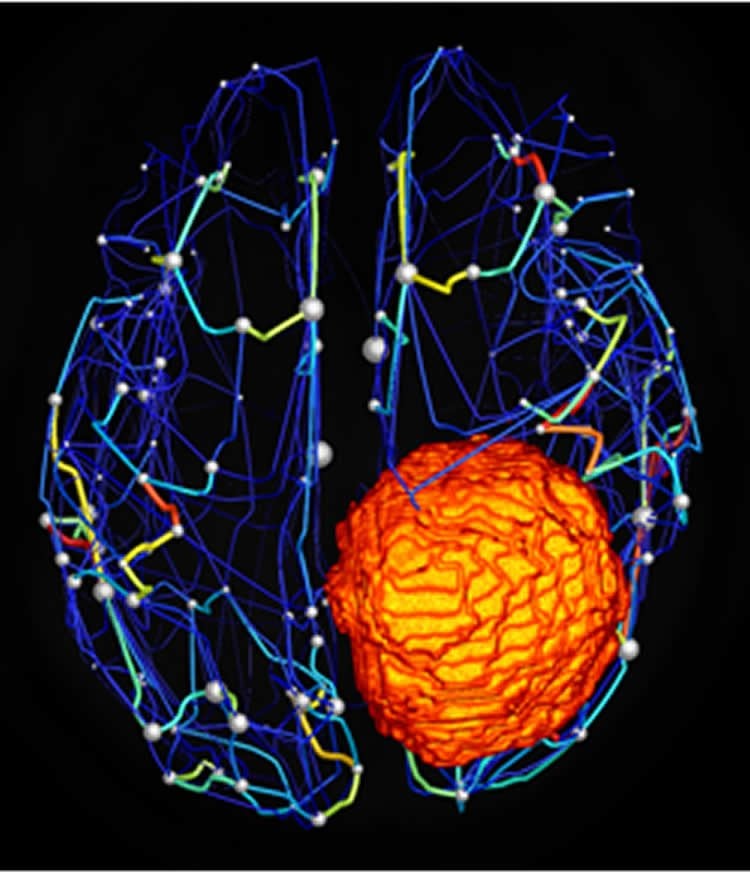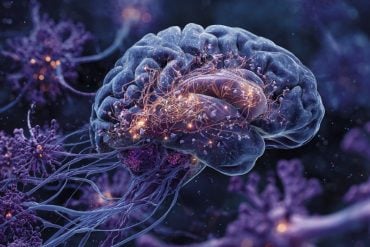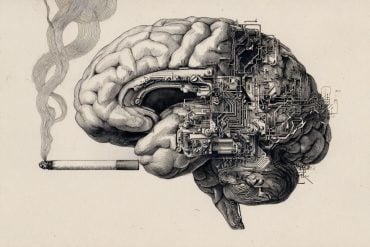Summary: Using an open source platform called The Virtual Brain, researchers have simulated neural activity based on individual patient brain tumors.
Source: SfN.
Researchers have simulated neural activity based on the unique structural architecture of individual brain tumor patients using a platform called The Virtual Brain. The findings, reported in eNeuro, are a first step toward creating personalized brain models that could be used to predict the effects of tumors and consequent surgery on brain function.
Brain surgery is delicate work that requires careful planning to maximally remove a tumor while leaving the surrounding tissue intact. Common techniques such as functional magnetic resonance imaging (fMRI) are used to map out a surgical strategy by identifying important functional areas close to the tumor. These approaches are limited, however, in their ability to predict post-surgical outcome because of the complex dynamics of the brain and the widespread modifications of brain activity.
Using the open-source software The Virtual Brain, Hannelore Aerts and a team led by Daniele Marinazzo modeled 25 individual brain networks of brain tumor patients and 11 of their partners as a control group. The researchers demonstrated that these individualized models can accurately predict the effects of the tumors on brain connectivity.

This result opens the possibility of integrating neuroimaging data with virtual brain modeling to improve surgical planning and outcomes.
Source: SfN
Publisher: Organized by NeuroscienceNews.com.
Image Source: NeuroscienceNews.com image is credited to the researchers.
Original Research: Abstract for “Modeling Brain Dynamics in Brain Tumor Patients Using the Virtual Brain” by Hannelore Aerts, Michael Schirner, Ben Jeurissen, Dirk Van Roost, Eric Achten, Petra Ritter and Daniele Marinazzo in eNeuro. Published May 28 2018.
doi:10.1523/ENEURO.0083-18.2018
[cbtabs][cbtab title=”MLA”]SfN “Virtual Brain Could Aid Surgical Planning.” NeuroscienceNews. NeuroscienceNews, 3 June 2018.
<https://neurosciencenews.com/virtual-brain-surgery-9228/>.[/cbtab][cbtab title=”APA”]SfN (2018, June 3). Virtual Brain Could Aid Surgical Planning. NeuroscienceNews. Retrieved June 3, 2018 from https://neurosciencenews.com/virtual-brain-surgery-9228/[/cbtab][cbtab title=”Chicago”]SfN “Virtual Brain Could Aid Surgical Planning.” https://neurosciencenews.com/virtual-brain-surgery-9228/ (accessed June 3, 2018).[/cbtab][/cbtabs]
Abstract
Modeling Brain Dynamics in Brain Tumor Patients Using the Virtual Brain
Presurgical planning for brain tumor resection aims at delineating eloquent tissue in the vicinity of the lesion to spare during surgery. To this end, non-invasive neuroimaging techniques such as functional MRI and diffusion weighted imaging fiber tracking are currently employed. However, taking into account this information is often still insufficient, as the complex non-linear dynamics of the brain impede straightforward prediction of functional outcome after surgical intervention. Large-scale brain network modeling carries the potential to bridge this gap by integrating neuroimaging data with biophysically based models to predict collective brain dynamics. As a first step in this direction, an appropriate computational model has to be selected, after which suitable model parameter values have to be determined. To this end, we simulated large-scale brain dynamics in 25 human brain tumor patients and 11 human control participants using The Virtual Brain, an open-source neuroinformatics platform. Local and global model parameters of the Reduced Wong-Wang model were individually optimized and compared between brain tumor patients and control subjects. In addition, the relationship between model parameters and structural network topology and cognitive performance was assessed. Results showed (1) significantly improved prediction accuracy of individual functional connectivity when using individually optimized model parameters; (2) local model parameters can differentiate between regions directly affected by a tumor, regions distant from a tumor, and regions in a healthy brain; and (3) interesting associations between individually optimized model parameters and structural network topology and cognitive performance.
Significance Statement
Individualized medicine is increasingly put forward as an important means to advance medical care. In this regard, the neuroinformatics platform “The Virtual Brain” holds great promise, given its direct focus on simulation of subject-specific brain activity. Reliable prediction of patient-specific large-scale brain dynamics would open up the possibility to virtually lesion structural connectomes, making computational models unique predictive tools to investigate the impact of diverse structural connectivity alterations on brain functioning, including those purposefully induced by surgery. Results of this study establish the basis for this purpose, by demonstrating individual specificity of biophysical model parameters, differences in local model parameters dependent on distance from a tumor, and associations between model parameters and structural network topology and cognitive performance.






